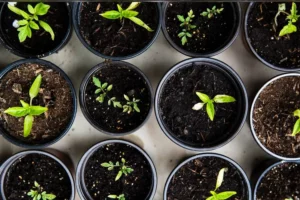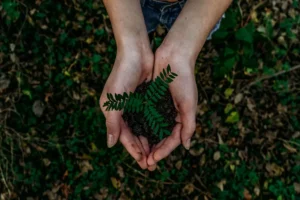The Ideal Conditions for Seedling Growth, Every want to know, How it possible? What is actual Process? Here implement some expertise and successful process. Seedlings are the heartbeats of a thriving garden. As any experienced gardener knows, ensuring the perfect environment for your seedlings is crucial for their healthy development. We will explore the optimal temperature range for seedlings and why maintaining it is vital for their growth.
Understanding Seedling Sensitivity
Seedlings, in their tender infancy, are highly sensitive to temperature fluctuations. Too cold or too hot, and their growth can be stunted or even irreversibly damaged. To achieve the best results, it’s essential to comprehend the specific temperature range that seedlings thrive in.

The Goldilocks Zone: Just Right Temperature
Seedlings generally thrive in a temperature range between 65°F to 75°F (18°C to 24°C). This temperature range is often referred to as the “Goldilocks zone” because it’s just right for their development. Let’s delve deeper into why this range is ideal.
Why Too Cold is Detrimental
Slow Growth
When temperatures drop below 50°F (10°C), seedlings tend to grow at a snail’s pace. This slow growth can delay transplanting and ultimately reduce the yield of your garden.
Frost Damage
Exposure to frost is a seedling’s worst nightmare. Anything below freezing (32°F or 0°C) can cause severe damage or even kill the delicate plants.
Root Problems
Cold soil inhibits root development, making it challenging for seedlings to absorb nutrients and water efficiently.
Why Too Hot Spells Trouble
Heat Stress
Temperatures exceeding 85°F (29°C) can lead to heat stress in seedlings. They may wilt, and their leaves may become scorched.
Drying Out
Hot conditions can cause the soil to dry out quickly, leaving seedlings parched and struggling to survive.
Pest Infestations
High temperatures can attract pests that prey on weakened plants, further endangering your seedlings.
Maintaining Optimal Conditions
Now that you know the ideal temperature range for seedlings, here are some tips to maintain these conditions:
Use a Heat Mat
During colder months, consider using a heat mat under your seed trays to provide the necessary warmth.
Ventilation
When it’s too hot, ensure proper ventilation in your growing area to prevent heat buildup.
Shade Cloth
Shield your seedlings from scorching sunlight by using shade cloth during excessively hot days.
Mulch
Applying mulch can help regulate soil temperature and moisture levels.
Thermometer
Always use a thermometer to monitor the temperature in your growing area.
What are the ideal circumstances for seedling growth?
To ensure healthy growth for seedlings, you need to provide the right conditions. Here are some crucial considerations:
Light
Seedlings require adequate light to grow. Place them in a location with bright, indirect sunlight or use fluorescent or LED grow lights if natural light is insufficient. Make certain they get 12 to 16 hours of light each day.
Temperature
Keep the temperature within an acceptable range for the particular plant species. Generally, most seedlings thrive in temperatures between 65-75°F (18-24°C). Use a heating mat or small heater if necessary.
Soil
Choose a high-quality, well-draining potting mix that is appropriate for seedlings. Sterilized soil helps prevent diseases. Consider using seed-starting trays or containers.

By watering it, you can keep the soil evenly moist but not drenched. Seedlings can die from damping-off disease, which can be caused by overwatering. To avoid upsetting the delicate seedlings, use a gentle mist or a bottom-watering technique.
Humidity
Maintain a higher humidity level around the seedlings. You can achieve this by using a humidity dome or placing a plastic cover over the seed trays. Mist the seedlings regularly, especially in dry indoor environments.
Air Circulation
Good air flow helps keep mold and fungus problems at bay. Use a small fan on low settings to gently circulate air around the seedlings.
Fertilization
A healthy growth requires nutrients for seedlings. Once they have produced their first real leaves (not the first cotyledons), begin using a diluted, balanced liquid fertilizer. Observe the guidelines listed on the fertilizer label.
Spacing
Properly space seedlings to prevent overcrowding, which can lead to competition for resources and disease. Transplant seedlings when they have outgrown their initial containers.
Thinning
If you sow multiple seeds in one container, thin them out to leave only the strongest seedling. This ensures each plant has enough space and resources to thrive.
Labeling
Keep track of the types of seeds you’re growing by labeling each container or tray. This will help you identify your plants and monitor their progress.
Transplanting
Transplant seedlings onto larger pots or your garden once they have grown strong and large enough. Handle the sensitive roots with care.
Management of Pests and Diseases
Regularly check your seedlings for pest or disease symptoms. To avoid injury, early detection and treatment are essential.
Hardening Off
Before moving seedlings outdoors permanently, gradually expose them to outdoor conditions for a week or two to acclimate them to the change in environment. Start with short periods and gradually increase the exposure.

That different plant species may have specific requirements, so it’s essential to research the needs of the particular seeds you’re growing. Consistently providing these optimal conditions will help ensure robust and healthy seedling growth.
What are the four prerequisites for a seed to sprout?
For a seed to germinate, four primary conditions are necessary:
Water
Water is essential for the germination process because it softens the seed coat and activates enzymes that break down stored nutrients within the seed, making them available for the growing embryo. Without water, the seed remains dormant.
Temperature
The right temperature range is crucial for germination. Different plants have specific temperature requirements, but generally, seeds need a temperature that falls within their optimal range. Cold temperatures can inhibit germination, while excessive heat can be detrimental.
Oxygen
Like all living organisms, the embryo inside the seed requires oxygen for respiration, which provides energy for growth. Adequate oxygen levels in the soil or growing medium are necessary for germination to occur. Poorly aerated soils can suffocate the seed, hindering germination.
Light (for some seeds)
While light is not a universal requirement for all seeds, some seeds, such as those from certain weeds and very small seeds, may require exposure to light to trigger germination. However, many seeds germinate in darkness, so this condition is not applicable to all plant species.
These four conditions, along with suitable soil or growing medium and proper planting depth, play crucial roles in the successful germination of seeds, allowing them to sprout and begin their journey to becoming mature plants.
What is the ideal temperature for optimum growth of seedlings?
The ideal temperature for the optimum growth of seedlings can vary depending on the specific plant species, but in general, a temperature range between 70°F to 75°F (21°C to 24°C) is often considered suitable for many common garden vegetables and flowering plants. However, it’s essential to note that different plants have different temperature preferences, so it’s important to research the specific requirements for the type of seedlings you are growing.
Here are some general temperature guidelines for seedling growth:
Cool-season crops (e.g., lettuce, spinach, and peas) tend to thrive in cooler temperatures, with an ideal range of 50°F to 70°F (10°C to 21°C).
Warm-season crops (e.g., tomatoes, peppers, and cucumbers) require warmer conditions and typically do best in temperatures between 70°F to 85°F (21°C to 29°C).
Some plants, like tropical species, may require even higher temperatures, often exceeding 85°F (29°C) for optimal growth.
It’s also important to consider nighttime temperatures, as they can affect seedling growth. Many plants benefit from a slight drop in temperature at night, usually around 10°F (5-6°C) lower than the daytime temperature.
Temperature fluctuations should be gradual and not extreme, as sudden temperature swings can stress seedlings.
Remember, The Ideal Conditions for Seedling Growth, that means providing the right temperature is just one aspect of successful seedling growth. Other factors like light, moisture, and nutrient levels also play crucial roles in ensuring healthy seedling development. It’s best to consult specific guidelines for the particular plants you are growing to achieve the best results.
Final Thought
In the world of gardening, maintaining the right temperature for your seedlings is akin to nurturing a delicate ecosystem. Too cold or too hot, and the balance is disrupted. By keeping your seedlings in the “Goldilocks zone” of 65°F to 75°F (18°C to 24°C), you’ll ensure their robust growth and a bountiful harvest in your garden. Remember, temperature control is the key to unlocking gardening success.